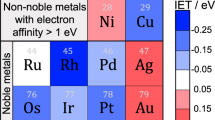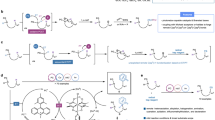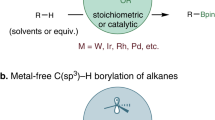Abstract
Metallaphotoredox catalysis merging photocatalysis and transition metal catalysis is now the most efficient platform for sp3 C–H functionalizations due to its very efficient activation and transformation capability. In such a process, photocatalysis is usually in charge of C–H bond activation to generate an sp3-hybridized carbon-centred radical, whereas transition metal catalysis is in charge of the subsequent transformation of this radical. Here we review advances in sp3 C–H functionalizations under matallaphotoredox catalysis via photocatalytic single-electron transfer mechanisms as opposed to hydrogen atom transfer processes. The delineation of these advancements is initially organized according to distinct sp3 C–H bonds and subsequently categorized by various transition metal catalytic systems. We encompass a thorough exploration of diverse metallaphotoredox catalysis strategies, along with their synthetic applications and mechanisms. Similarities and differences between these strategies are described to inspire new reaction designs, thus promoting further development of this field.

This is a preview of subscription content, access via your institution
Access options
Access Nature and 54 other Nature Portfolio journals
Get Nature+, our best-value online-access subscription
$32.99 / 30 days
cancel any time
Subscribe to this journal
Receive 12 digital issues and online access to articles
$119.00 per year
only $9.92 per issue
Buy this article
- Purchase on SpringerLink
- Instant access to full article PDF
Prices may be subject to local taxes which are calculated during checkout








Similar content being viewed by others
References
Prier, C. K., Rankic, D. A. & MacMillan, D. W. C. Visible light photoredox catalysis with transition metal complexes: applications in organic synthesis. Chem. Rev. 113, 5322–5363 (2013).
Romero, N. A. & Nicewicz, D. A. Organic photoredox catalysis. Chem. Rev. 116, 10075–10166 (2016).
Yi, H. et al. Recent advances in radical C–H activation/radical cross-coupling. Chem. Rev. 117, 9016–9085 (2017).
Wang, H., Gao, X., Lv, Z., Abdelilah, T. & Lei, A. Recent advances in oxidative R1–H/R2–H cross-coupling with hydrogen evolution via photo-/electrochemistry. Chem. Rev. 119, 6769–6787 (2019).
Kwon, K., Simons, R. T., Nandakumar, M. & Roizen, J. L. Strategies to generate nitrogen-centered radicals that may rely on photoredox catalysis: development in reaction methodology and applications in organic synthesis. Chem. Rev. 122, 2353–2428 (2021).
Bellotti, P., Huang, H., Faber, T. & Glorius, F. Photocatalytic late-stage C–H functionalization. Chem. Rev. 123, 4237–4352 (2023).
Rehm, D. & Weller, A. Kinetics of fluorescence quenching by electron and H-atom transfer. Isr. J. Chem. 8, 259–271 (1970).
Twilton, J. et al. The merger of transition metal and photocatalysis. Nat. Rev. Chem. 1, 0052 (2017).
Yuan, W., Zheng, S. & Hu, Y. Recent advances in C(sp3)–C(sp3) cross-coupling via metallaphotoredox strategies. Synthesis 53, 1719–1733 (2020).
Lu, F., He, G., Lu, L. & Xiao, W. Metallaphotoredox catalysis for multicomponent coupling reactions. Green Chem. 23, 5379–5393 (2021).
Sarkar, T., Shah, T. A., Maharana, P. K., Debnath, B. & Punniyamurthy, T. Dual metallaphotoredox‐catalyzed directed C(sp2)–H functionalization: access to C–C/C–heteroatom bonds. Eur. J. Org. Chem. 2022, e202200541 (2022).
Chan, A. Y. et al. Metallaphotoredox: the merger of photoredox and transition metal catalysis. Chem. Rev. 122, 1485–1542 (2022).
Singh, P. P., Singh, P. K. & Srivastava, V. Visible light metallaphotoredox catalysis in the late-stage functionalization of pharmaceutically potent compounds. Org. Chem. Front. 10, 216–236 (2023).
Zhang, J. C. & Rueping, M. Metallaphotoredox catalysis for sp3 C–H functionalizations through hydrogen atom transfer (HAT). Chem. Soc. Rev. 52, 4099–4120 (2023).
Freeman, D. B., Furst, L., Condie, A. G. & Stephenson, C. R. J. Functionally diverse nucleophilic trapping of iminium intermediates generated utilizing visible light. Org. Lett. 14, 94–97 (2012).
McNally, A., Prier, C. K. & MacMillan, D. W. C. Discovery of an α-amino C–H arylation reaction using the strategy of accelerated serendipity. Science 334, 1114–1117 (2011).
Muralirajan, K., Kancherla, R. & Rueping, M. Dehydrogenative aromatization and sulfonylation of pyrrolidines: orthogonal reactivity in photoredox catalysis. Angew. Chem. Int. Ed. 57, 14787–14791 (2018).
Kumar, G. S. et al. Paired electrolysis for decarboxylative cyanation: 4-CN-pyridine, a versatile nitrile source. Org. Lett. 24, 6357–6363 (2022).
Zhang, J. C. et al. Visible-light-induced benzylic C–H functionalization for the synthesis of 2-arylquinazolines. Eur. J. Org. Chem. 2019, 5934–5936 (2019).
Huang, C., Li, J. & Li, C. A cross-dehydrogenative C(sp3)–H heteroarylation via photo-induced catalytic chlorine radical generation. Nat. Commun. 12, 4010 (2021).
Zhu, C., Yue, H., Nikolaienko, P. & Rueping, M. Merging electrolysis and nickel catalysis in redox neutral cross-coupling reactions: experiment and computation for electrochemically induced C–P and C–Se bonds formation. CCS Chem. 2, 179–190 (2020).
Zhu, C., Kale, A. P., Yue, H. & Rueping, M. Redox-neutral cross-coupling amination with weak N-nucleophiles: arylation of anilines, sulfonamides, sulfoximines, carbamates, and imines via nickelaelectrocatalysis. JACS Au 1, 1057–1065 (2021).
Kancherla, R., Muralirajan, K. & Rueping, M. Excited-state palladium-catalysed reductive alkylation of imines: scope and mechanism. Chem. Sci. 13, 8583–8589 (2022).
Zuo, Z. et al. Merging photoredox with nickel catalysis: coupling of α-carboxyl sp3-carbons with aryl halides. Science 345, 437–440 (2014). Report of photoredox/nickel catalysis realizing the cross-coupling of anilines and aryl halides.
Maity, B., Zhu, C., Rueping, M. & Cavallo, L. Mechanistic understanding of arylation vs alkylation of aliphatic \({\mathrm{C}}_{sp^3}\)–H bonds by decatungstate–nickel catalysis. ACS Catal. 11, 13973–13982 (2021).
Joe, C. L. & Doyle, A. G. Direct acylation of C(sp3)–H bonds enabled by nickel and photoredox catalysis. Angew. Chem. Int. Ed. 55, 4040–4043 (2016).
Ahneman, D. T. & Doyle, A. G. C–H functionalization of amines with aryl halides by nickel-photoredox catalysis. Chem. Sci. 7, 7002–7006 (2016).
Gui, Y. et al. Arylation of aniline C(sp3)–H bonds with phenols via an in situ activation strategy. Asian J. Org. Chem. 7, 537–541 (2017).
Trost, B. M. & Crawley, M. L. Asymmetric transition-metal-catalyzed allylic alkylations: applications in total synthesis. Chem. Rev. 103, 2921–2944 (2003).
Norsikian, S. & Chang, C. Control of the regioselectivity in palladium(0)-catalyzed allylic alkylation. Curr. Org. Synth. 6, 264–289 (2009).
Xuan, J. et al. Redox-neutral α-allylation of amines by combining palladium catalysis and visible-light photoredox catalysis. Angew. Chem. Int. Ed. 54, 1625–1628 (2014). Report of photoredox/palladium catalysis-mediated α-allylation between N-alkyl anilines and diethyl phosphates.
Zhang, H., Zhao, J. & Yu, S. Enantioselective α-allylation of anilines enabled by a combined palladium and photoredox catalytic system. ACS Catal. 10, 4710–4716 (2020).
Masuda, Y., Ito, M. & Murakami, M. Dehydrative allylation of α C(sp3)–H bonds of alkylamines with allylic alcohols. Org. Lett. 22, 4467–4470 (2020).
Rueping, M. et al. Dual catalysis: combination of photocatalytic aerobic oxidation and metal catalyzed alkynylation reactions—C–C bond formation using visible light. Chem. Eur. J. 18, 5170–5174 (2012). Report combining photocatalysis and copper catalysis for the alkynylation of amines using air as a green oxidant.
Perepichka, I., Kundu, S., Hearne, Z. & Li, C. Efficient merging of copper and photoredox catalysis for the asymmetric cross-dehydrogenative-coupling of alkynes and tetrahydroisoquinolines. Org. Biomol. Chem. 13, 447–451 (2015).
Yeung, C. S. & Dong, V. M. Catalytic dehydrogenative cross-coupling: forming carbon–carbon bonds by oxidizing two carbon–hydrogen bonds. Chem. Rev. 111, 1215–1292 (2011).
Meng, Q. et al. A cascade cross-coupling hydrogen evolution reaction by visible light catalysis. J. Am. Chem. Soc. 135, 19052–19055 (2013). Report of metellaphotoredox catalysis-mediated cross-dehydrogenative coupling with H2 evolution.
Zhong, J. et al. Cross-coupling hydrogen evolution reaction in homogeneous solution without noble metals. Org. Lett. 16, 1988–1991 (2014). Report of photoredox/cobalt catalysis to unearth the high efficiency of cobalt for H2 evolution.
Gao, X. et al. Visible light catalysis assisted site-specific functionalization of amino acid derivatives by C–H bond activation without oxidant: cross-coupling hydrogen evolution reaction. ACS Catal. 5, 2391–2396 (2015).
Yang, Q. et al. Visible‐light‐promoted asymmetric cross‐dehydrogenative coupling of tertiary amines to ketones by synergistic multiple catalysis. Angew. Chem. Int. Ed. 56, 3694–3698 (2017).
Niu, L. et al. Visible light-mediated oxidative C(sp3)–H phosphonylation for α-aminophosphonates under oxidant-free conditions. Chem. Commun. 54, 1659–1662 (2018).
Tucker, J. W. & Stephenson, C. R. J. Shining light on photoredox catalysis: theory and synthetic applications. J. Org. Chem. 77, 1617–1622 (2012).
Rueping, M. et al. Light-mediated heterogeneous cross dehydrogenative coupling reactions: metal oxides as efficient, recyclable, photoredox catalysts in C–C bond-forming reactions. Chem. Eur. J. 18, 3478–3481 (2012).
Zhu, S. & Rueping, M. Merging visible-light photoredox and Lewis acid catalysis for the functionalization and arylation of glycine derivatives and peptides. Chem. Commun. 48, 11960–11962 (2012).
Rueping, M., Vila, C., Koenigs, R. M., Poscharny, K. & Fabry, D. C. Dual catalysis: combining photoredox and Lewis base catalysis for direct Mannich reactions. Chem. Commun. 47, 2360–2362 (2011).
Hou, H., Zhu, S., Atodiresei, I. & Rueping, M. Asymmetric organocatalysis and photoredox catalysis for the α-functionalization of tetrahydroisoquinolines. Eur. J. Org. Chem. 2018, 1277–1280 (2018).
Thullen, S. M. & Rovis, T. A mild hydroaminoalkylation of conjugated dienes using a unified cobalt and photoredox catalytic system. J. Am. Chem. Soc. 139, 15504–15508 (2017).
He, K. et al. Acceptorless dehydrogenation of N-heterocycles by merging visible-light photoredox catalysis and cobalt catalysis. Angew. Chem. Int. Ed. 56, 3080–3084 (2017).
Sahoo, M. K. & Balaraman, E. Room temperature catalytic dehydrogenation of cyclic amines with the liberation of H2 using water as a solvent. Green Chem. 21, 2119–2128 (2019).
Fabry, D. C., Zoller, J., Raja, S. & Rueping, M. Combining rhodium and photoredox catalysis for C–H functionalizations of arenes: oxidative heck reactions with visible light. Angew. Chem. Int. Ed. 53, 10228–10231 (2014).
Zheng, J. & Breit, B. Regiodivergent hydroaminoalkylation of alkynes and allenes by a combined rhodium and photoredox catalytic system. Angew. Chem. Int. Ed. 58, 3392–3397 (2019).
Huang, L. et al. Modulating stereoselectivity in allylic C(sp3)–H bond arylations via nickel and photoredox catalysis. Nat. Commun. 14, 548 (2023).
Okude, Y., Hirano, S., Hiyama, T. & Nozaki, H. Grignard-type carbonyl addition of allyl halides by means of chromous salt. A chemospecific synthesis of homoallyl alcohols. J. Am. Chem. Soc. 99, 3179–3181 (1977).
Jin, H., Uenishi, J., Christ, W. J. & Kishi, Y. Catalytic effect of nickel(ii) chloride and palladium(ii) acetate on chromium(ii)-mediated coupling reaction of iodo olefins with aldehydes. J. Am. Chem. Soc. 108, 5644–5646 (1986).
Takai, K. et al. Reactions of alkenylchromium reagents prepared from alkenyl trifluoromethanesulfonates (triflates) with chromium(ii) chloride under nickel catalysis. J. Am. Chem. Soc. 108, 6048–6050 (1986).
Fürstner, A. & Shi, N. Nozaki–Hiyama–Kishi reactions catalytic in chromium. J. Am. Chem. Soc. 118, 12349–12357 (1996).
Schwarz, J. L., Schäfers, F., Tlahuext-Aca, A., Lückemeier, L. & Glorius, F. Diastereoselective allylation of aldehydes by dual photoredox and chromium catalysis. J. Am. Chem. Soc. 140, 12705–12709 (2018). Development of the Nozaki–Hiyama–Kishi reaction realized under very mild conditions with the assistance of photocatalysis.
Schäfers, F. et al. Direct access to monoprotected homoallylic 1,2-diols via dual chromium/photoredox catalysis. ACS Catal. 10, 11841–11847 (2020).
Mitsunuma, H., Tanabe, S., Fuse, H., Ohkubo, K. & Kanai, M. Catalytic asymmetric allylation of aldehydes with alkenes through allylic C(sp3)–H functionalization mediated by organophotoredox and chiral chromium hybrid catalysis. Chem. Sci. 10, 3459–3465 (2019).
Yue, H., Zhu, C., Huang, L., Dewanji, A. & Rueping, M. Advances in allylic and benzylic C–H bond functionalization enabled by metallaphotoredox catalysis. Chem. Commun. 58, 171–184 (2022).
Liu, H. et al. One-pot photomediated Giese reaction/Friedel–Crafts hydroxyalkylation/oxidative aromatization to access naphthalene derivatives from toluenes and enones. ACS Catal. 8, 6224–6229 (2018).
Kim, W., Koo, J. & Lee, H. S. Benzylic C(sp3)–C(sp2) cross-coupling of indoles enabled by oxidative radical generation and nickel catalysis. Chem. Sci. 12, 4119–4125 (2021).
Zhang, P., Le, C. & MacMillan, D. W. C. Silyl radical activation of alkyl halides in metallaphotoredox catalysis: a unique pathway for cross-electrophile coupling. J. Am. Chem. Soc. 138, 8084–8087 (2016).
Heitz, D. R., Tellis, J. C. & Molander, G. A. Photochemical nickel-catalyzed C–H arylation: synthetic scope and mechanistic investigations. J. Am. Chem. Soc. 138, 12715–12718 (2016).
Kariofillis, S. K. et al. Using data science to guide aryl bromide substrate scope analysis in a Ni/photoredox-catalyzed cross-coupling with acetals as alcohol-derived radical sources. J. Am. Chem. Soc. 144, 1045–1055 (2022).
Xiang, M. et al. Activation of C–H bonds through oxidant-free photoredox catalysis: cross-coupling hydrogen-evolution transformation of isochromans and β-keto esters. Chem. Eur. J. 21, 18080–18084 (2015).
Johnston, C. P., Smith, R. T., Allmendinger, S. & MacMillan, D. W. C. Metallaphotoredox-catalysed sp3–sp3 cross-coupling of carboxylic acids with alkyl halides. Nature 536, 322–325 (2016).
Yue, H., Zhu, C., Kancherla, R., Liu, F. & Rueping, M. Regioselective hydroalkylation and arylalkylation of alkynes by photoredox/nickel dual catalysis: application and mechanism. Angew. Chem. Int. Ed. 59, 5738–5746 (2020).
Tellis, J. C., Primer, D. N. & Molander, G. A. Single-electron transmetalation in organoboron cross-coupling by photoredox/nickel dual catalysis. Science 345, 433–436 (2014).
Primer, D. N. & Molander, G. A. Enabling the cross-coupling of tertiary organoboron nucleophiles through radical-mediated alkyl transfer. J. Am. Chem. Soc. 139, 9847–9850 (2017).
Corcé, V. et al. Silicates as latent alkyl radical precursors: visible‐light photocatalytic oxidation of hypervalent bis‐catecholato silicon compounds. Angew. Chem. Int. Ed. 54, 11414–11418 (2015).
Jouffroy, M., Primer, D. N. & Molander, G. A. Base-free photoredox/nickel dual-catalytic cross-coupling of ammonium alkylsilicates. J. Am. Chem. Soc. 138, 475–478 (2016).
Yayla, H. G., Wang, H., Tarantino, K. T., Orbe, H. S. & Knowles, R. R. Catalytic ring-opening of cyclic alcohols enabled by PCET activation of strong O–H bonds. J. Am. Chem. Soc. 138, 10794–10797 (2016).
Ji, T., Chen, X., Huang, L. & Rueping, M. Remote trifluoromethylthiolation enabled by organophotocatalytic C–C bond cleavage. Org. Lett. 22, 2579–2583 (2020).
Huang, L., Ji, T. & Rueping, M. Remote nickel-catalyzed cross-coupling arylation via proton-coupled electron transfer-enabled C–C bond cleavage. J. Am. Chem. Soc. 142, 3532–3539 (2020).
Huang, L. et al. Bioinspired desaturation of alcohols enabled by photoredox proton-coupled electron transfer and cobalt dual catalysis. Nat. Commun. 13, 809 (2022).
Nakajima, K., Nojima, S. & Nishibayashi, Y. Nickel- and photoredox-catalyzed cross-coupling reactions of aryl halides with 4-alkyl-1,4-dihydropyridines as formal nucleophilic alkylation reagents. Angew. Chem. Int. Ed. 55, 14106–14110 (2016).
Yue, H. et al. Nickel-catalyzed C–N bond activation: activated primary amines as alkylating reagents in reductive cross-coupling. Chem. Sci. 10, 4430–4435 (2019).
Knauber, T. et al. Ru/Ni dual catalytic desulfinative photoredox \({\mathrm{C}}_{sp^2}-{\mathrm{C}}_{sp^3}\) cross-coupling of alkyl sulfinate salts and aryl halides. Org. Lett. 19, 6566–6569 (2017).
Yue, H., Zhu, C. & Rueping, M. Cross-coupling of sodium sulfinates with aryl, heteroaryl, and vinyl halides by nickel/photoredox dual. Catal. Angew. Chem. Int. Ed. 57, 1371–1375 (2018).
Kim, H. J., Fabry, D. C., Mader, S. & Rueping, M. Photoredox/rhodium catalysis in C–H activation for the synthesis of nitrogen containing heterocycles. Org. Chem. Front. 6, 2319–2323 (2019).
Zhu, C., Yue, H., Jia, J. & Rueping, M. Nickel‐catalyzed C–heteroatom cross‐coupling reactions under mild conditions via facilitated reductive elimination. Angew. Chem. Int. Ed. 60, 17810–17831 (2021).
Zhu, C. et al. A multicomponent synthesis of stereodefined olefins via nickel catalysis and single electron/triplet energy transfer. Nat. Catal. 2, 678–687 (2019).
Huang, L. et al. Cascade cross‐coupling of dienes: photoredox and nickel dual. Catal. Angew. Chem. Int. Ed. 59, 457–464 (2020).
Zhu, C., Yue, H., Chu, L. & Rueping, M. Recent advances in photoredox and nickel dual-catalyzed cascade reactions: pushing the boundaries of complexity. Chem. Sci. 11, 4051–4064 (2020).
Zhu, C., Yue, H. & Rueping, M. Nickel catalyzed multicomponent stereodivergent synthesis of olefins enabled by electrochemistry, photocatalysis and photo-electrochemistry. Nat. Commun. 13, 3240 (2022).
Kumar, G. S. et al. Nickel‐catalyzed chain‐walking cross‐electrophile coupling of alkyl and aryl halides and olefin hydroarylation enabled by electrochemical reduction. Angew. Chem. Int. Ed. 59, 6513–6519 (2020).
Zhu, C., Lee, S., Chen, H., Yue, H. & Rueping, M. Reductive cross‐coupling of α‐oxy halides enabled by thermal catalysis, photocatalysis, electrocatalysis, or mechanochemistry. Angew. Chem. Int. Ed. 61, e202204212 (2022).
Yi, L., Ji, T., Chen, K., Chen, X. & Rueping, M. Nickel-catalyzed reductive cross-couplings: new opportunities for carbon–carbon bond formations through photochemistry and electrochemistry. CCS Chem. 4, 9–30 (2022).
Chen, H., Zhu, C., Yue, H. & Rueping, M. Carbon–germanium bond formation via low-valent cobalt-catalyzed cross-electrophile coupling. ACS Catal. 13, 6773–6780 (2023).
Li, P. et al. Research progress in organic synthesis by means of photoelectrocatalysis. Chem. Rec. 21, 841–857 (2021).
Hardwick, T. & Ahmed, N. C–H functionalization via electrophotocatalysis and photoelectrochemistry: complementary synthetic approach. ACS Sustain. Chem. Eng. 9, 4324–4340 (2021).
Huang, H., Steiniger, K. A. & Lambert, T. H. Electrophotocatalysis: combining light and electricity to catalyze reactions. J. Am. Chem. Soc. 144, 12567–12583 (2022).
Yue, H., Zhu, C. & Rueping, M. Trisaminocyclopropenium ion (TAC+) enables contiguous C–H bonds oxygenations via oxidative electrophotocatalysis. Sci. Bull. 68, 367–369 (2023).
Lee, S., Choi, D., Kuk, S. & Park, C. Photobiocatalysis: activating redox enzymes by direct or indirect transfer of photoinduced electrons. Angew. Chem. Int. Ed. 57, 7958–7985 (2018).
Schmermund, L. et al. Photo-biocatalysis: biotransformations in the presence of light. ACS Catal. 9, 4115–4144 (2019).
Peng, Y., Chen, Z., Xu, J. & Wu, Q. Recent advances in photobiocatalysis for selective organic synthesis. Org. Process Res. Dev. 26, 1900–1913 (2022).
Bau, J. A. et al. Mo3+ hydride as the common origin of H2 evolution and selective NADH regeneration in molybdenum sulfide electrocatalysts. Nat. Catal. 5, 397–404 (2022).
Acknowledgements
J.Z. thanks the Jining Medical University High-Level Research Foundation for financial support (600497001 and 600497002). M.R. thanks the Office of Sponsored Research at King Abdullah University of Science and Technology in Saudi Arabia for financial support (URF/1/4405).
Author information
Authors and Affiliations
Corresponding authors
Ethics declarations
Competing interests
The authors declare no competing interests.
Peer review
Peer review information
Nature Catalysis thanks Wei Guan and the other, anonymous, reviewer(s) for their contribution to the peer review of this work.
Additional information
Publisher’s note Springer Nature remains neutral with regard to jurisdictional claims in published maps and institutional affiliations.
Rights and permissions
Springer Nature or its licensor (e.g. a society or other partner) holds exclusive rights to this article under a publishing agreement with the author(s) or other rightsholder(s); author self-archiving of the accepted manuscript version of this article is solely governed by the terms of such publishing agreement and applicable law.
About this article
Cite this article
Zhang, J., Rueping, M. Metallaphotoredox catalysis for sp3 C–H functionalizations through single-electron transfer. Nat Catal 7, 963–976 (2024). https://doi.org/10.1038/s41929-024-01215-3
Received:
Accepted:
Published:
Issue date:
DOI: https://doi.org/10.1038/s41929-024-01215-3
This article is cited by
-
A scalable photo-mechanochemical platform for sustainable photoredox catalysis by resonant acoustic mixing
Nature Communications (2025)



